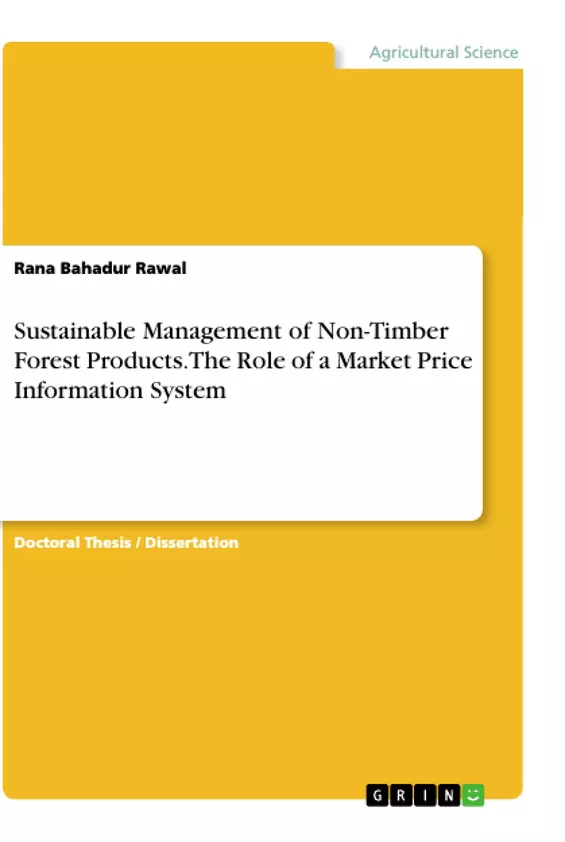The study aims to identify the role of market price information system in distribution of non-timber forest products (NTFPs) among the usufructs and sustainable management of NTFPs in long run. Information of market and price of NTFPs is important for usufructs to protect the forest and timely cultivate and harvest the non-timber forest product. The study has explored the knowledge and accessibility of usufructs on MPIS of NTFPs, current practice of MPIS, effectiveness of MPIS and challenges and opportunity of equitable distribution of NTFPs among usufructs. The study was based on the cross-sectional descriptive and exploratory research design. Data was collected from 466 respondents of Dolpa, Salyan and Banke districts of Nepal. Mixed method was adopted to collect the data. Simple random sampling technique was used to select the respondents. Structured questionnaire survey and semi-structured interviews were done to collect the quantitative and qualitative data. Statistical models like cross-tabulation, Chi-Square test and ANOVA were used for data analysis.
Inhaltsverzeichnis (Table of Contents)
- CHAPTER ONE
- INTRODUCTION
- Background of the Study
- Statement of Research Problem
- Significance of the Research
- Research Objectives
- Research Hypothesis
- Research Questions
- Philosophical Worldviews
- Theoretical Framework
- Conceptual Framework
- Operational Definition of Key Words
- Limitation of the Research
- CHAPTER TWO
- REVIEW OF LITERATURE
- Source of Information of the MPIS amongst Usufructs
- Components of Management Information System
- Current Practices of Market Price Information System, Benefits
- The Current State of Marketing Information Practice in Nepal
- Functions of MPIS
- Benefits of MPIS
- Market Price Information System on Equitable Sharing and Benefits to Usufructs and sustainability of Non-Timber Forest Products
- Key Challenges and Opportunities in Equitable Distribution
- Theory of Management Information System
- Concept of Sustainable Development
- CHAPTER THREE
- RESEARCH METHODOLOGY
- Research Design
- Sampling Design
- Data collection strategies
- Study Framework
- Validity and Reliability of Research Instruments
- Data Analysis plan
- CHAPTER FOUR
- RESULT AND DISCUSSION
- Demographic Profile of the Respondents
- Community Forest Selected
- Social Characteristics of Respondents
- Knowledge, Accessibility of Usufructs on Market Price Information
- Market Price Information System of Non-Timber Forest
- Current Practice of Market Price Information System
- Effectiveness of Market Price Information System in Benefit
- Market Price Information System to Involve in Sustainable
- Need of Sustainability of Market Plan Information System
- Challenges and Opportunities in Equitable Distribution
- Testing of Research Hypothesis
- CHAPTER FIVE
- SUMMARY, CONCLUSION AND RECOMMENDATION
- Summary of the Study
Zielsetzung und Themenschwerpunkte (Objectives and Key Themes)
This study aims to investigate the role of market price information systems in the sustainable management of non-timber forest products in mid-western Nepal. The study seeks to understand the current practices, benefits, challenges, and opportunities associated with market price information systems in this region.
- The role of market price information systems in sustainable forest management
- The impact of market price information systems on equitable sharing and benefits for local communities
- Key challenges and opportunities for improving market price information systems in mid-western Nepal
- The relationship between market price information systems and the sustainable management of non-timber forest products
- The importance of integrating traditional knowledge and local practices in market price information systems.
Zusammenfassung der Kapitel (Chapter Summaries)
- Chapter One: Introduction This chapter provides a detailed background on the study, outlining the research problem, significance, objectives, hypothesis, research questions, philosophical worldview, theoretical and conceptual frameworks, and the limitations of the research. It emphasizes the importance of market price information systems in sustainable management of non-timber forest products.
- Chapter Two: Review of Literature This chapter examines the existing literature on market price information systems, their components, current practices, benefits, and challenges. It explores the relationship between market price information systems and equitable sharing of benefits, sustainability of non-timber forest products, and the concept of sustainable development.
- Chapter Three: Research Methodology This chapter details the research design, sampling design, data collection strategies, study framework, and data analysis plan employed in the study. It describes the methods used to collect and analyze data to ensure the validity and reliability of the findings.
- Chapter Four: Result and Discussion This chapter presents and discusses the results of the study, focusing on the demographic profile of respondents, knowledge and accessibility of usufructs on market price information, current practices of market price information systems, and the effectiveness of these systems in promoting sustainable management of non-timber forest products.
Schlüsselwörter (Keywords)
The study focuses on the market price information system, sustainable management, non-timber forest products, equitable distribution, and local communities in mid-western Nepal. It explores the relationship between these key elements and how they contribute to the sustainable utilization of forest resources.
- Quote paper
- Rana Bahadur Rawal (Author), 2019, Sustainable Management of Non-Timber Forest Products. The Role of a Market Price Information System, Munich, GRIN Verlag, https://www.grin.com/document/941418



